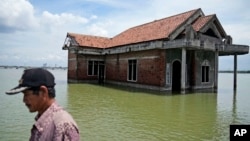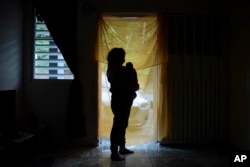A new study finds climate events such as flooding, heat waves and drought worsen more than half of the known diseases that infect people. These diseases include malaria, cholera and anthrax.
Researchers examined medical literature of established cases of such diseases. They found out that 218 out of the known 375 human infectious diseases, or 58 percent, seemed to be made worse by extreme weather connected to climate change. The results appeared this week in the publication Nature Climate Change.
The study connected more than 1000 pathways from climate events to sick people. In some cases, heavy rains and flooding sicken people through disease-carrying mosquitos, rats and deer. Other events, like warming oceans and heat waves, spoil seafood and droughts bring bats carrying viral infections to people.
Medical doctors, going back to the days of ancient Greek civilization, have long connected disease to weather. But this study shows how widespread the influence of climate is on human health.
“If climate is changing, the risk of these diseases are changing,” said study co-leader Dr. Jonathan Patz, director of the Global Health Institute at the University of Wisconsin-Madison.
Dr. Carlos del Rio is an Emory University infectious disease specialist who was not involved in the study. He said, “The findings of this study are terrifying and illustrate well the enormous consequences of climate change on human pathogens.”
Del Rio said humans “need to all work together to prevent” disaster from climate change.
In addition to looking at infectious diseases, the researchers explored data on all kinds of human sicknesses, including non-infectious conditions like asthma, allergies and animal bites. They wanted to learn how many sicknesses could connect to climate events in some way.
They found a total of 286 unique sicknesses, and 223 of them seemed to be worsened by climate events. The study found nine of the conditions were reduced by climate events.
Real-life examples
Camilo Mora, a climate data expert at the University of Hawaii, is a co-leader of the study. He said the study is not about predicting future cases. “These are things that have already happened,” he noted.
One example Mora knows from his own experience. About five years ago, Mora’s home in rural Colombia was flooded, creating a breeding ground for mosquitoes. Mora contracted Chikungunya, a virus spread by mosquito bites. He survived, but he still suffers pain related to the disease.
In another case, the remains of a reindeer dead from anthrax were unearthed as the Siberian permafrost melted from warming in 2016. A child touched the dead animal, got anthrax, and an outbreak spread.
Dr. Aaron Bernstein is with the Center for Climate, Health, and the Global Environment at Harvard School of Public Health. He and other outside experts said the study is a good warning about climate and health for now and the future.
Bernstein added in an email. “But of course, it only reports on what we already know and what’s yet unknown about pathogens may be yet more compelling about how preventing further climate change may prevent future disasters like COVID-19.”
I'm Caty Weaver.
Seth Borenstein reported this story for The Associated Press. Hai Do adapted the story for Learning English.
_______________________________________________________________________
Words in This Story
drought - n. a long period with little or no rain
spoil - v. to decay or lose freshness
illustrate - v. to be proof or evidence
enormous - adj. very great in size or amount
consequence - n. something that happens as a result of action or condition
pathogen - n. bacteria or virus that causes disease
unique - adj. very special
compelling - adj. very interesting







Forum